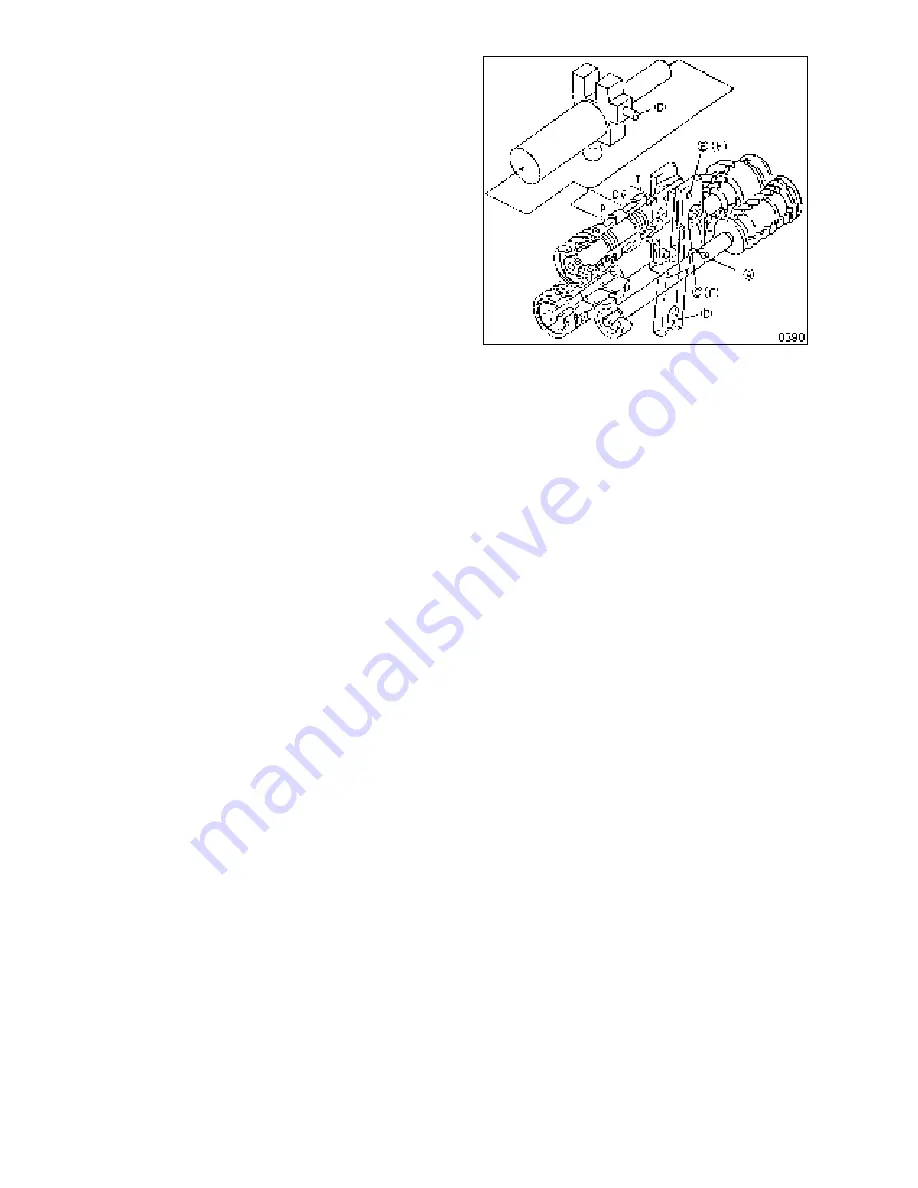
S0708320
Page 6
Main Pump (With Regulator)
Return to Master Table of Contents
PUMP REGULATOR DESCRIPTION
A regulator control valve is integrally-mounted to
the housing of each of the two variable
displacement hydraulic pumps (Figure 1). The
regulator valves perform the task of controlling
the rate of pump discharge for the main pump
assembly. Pump output may need to be varied
as a result of increased or decreased work load
demand, operator-input changes to control lever
position and/or to maintain balanced output
between pumps, increasing or decreasing the
discharge rate at one pump to compensate for
the output of the other pump.
The two regulators work in conjunction, varying
pilot pressure (Pi) through three different control
functions - "Horsepower Control," "Powershift
Control," and "Negative Control."
HORSEPOWER CONTROL
This hydraulic system design feature provides balanced pump output, maintaining steady and consistent
power production through the hydraulic system.
If there is a momentary increase of outlet pressure (P1) at one pump, the tilt angle of the swash plate in the
remaining pump is automatically reduced - decreasing the other pump’s outlet pressure (P2) - to equalize
system output. The advantage of this design feature is that it keeps available horsepower through the
system constant, directly proportional to the input rotational speed (rpm) of the engine.
POWER SHIFT CONTROL
This design feature modifies the total available power output of the hydraulic system through
microprocessor-controlled application of electronic controls. Supplementary electronic control of the
hydraulic system provides increased operating flexibility.
The electronic proportional reducing valve through which the system operates is just upstream from the 2
pump regulators. It responds directly to signals from the EPOS-V microprocessor and relays control
signals to each of the 2 pump regulators to optimize each pump’s power output, according to changes in
secondary pressure, Pf ("Powershift pressure").
Pf pressure is monitored from interior pump passages, through the horsepower control part of each pump
regulator. It allows simultaneous control of horsepower output at both pumps, for optimum, efficient
response to changing workload demand.
NEGATIVE OIL DISCHARGE (PUMP BYPASS) CONTROL
The volume of main pump bypass oil is automatically controlled by pilot pressure, which is regulated by the
position of the spool in the control valve. When the control valve spool is in the neutral position (high pilot
pressure, high bypass), the tilt angle of the swash plate decreases, reducing the volume of bypass oil
through the main pump. When the control valve spool is at maximum stroke (low pilot pressure), the tilt
angle of the swash plate increases, boosting main pump bypass oil volume.
Figure 6
Summary of Contents for Solar 225LC-V
Page 2: ......
Page 4: ......
Page 7: ...1SAFETY ...
Page 8: ......
Page 46: ...S0102000 Page 38 Track Excavator Safety ...
Page 47: ...1SPECIFICATIONS ...
Page 48: ......
Page 54: ...S0205015K Page 6 Specifications for Solar 225LC V Return to Master Table of Contents ...
Page 70: ...S0205015K Page 22 Specifications for Solar 225LC V Return to Master Table of Contents ...
Page 71: ...1GENERAL MAINTENANCE ...
Page 72: ......
Page 86: ...S0302000 Page 14 General Maintenance Procedures ...
Page 99: ...1UPPER STRUCTURE ...
Page 100: ......
Page 102: ...S0402040K Page 2 Cab TABLE OF CONTENTS Removal 3 Installation 6 ...
Page 116: ...S0403050K Page 8 Counterweight Return to Master Table of Contents ...
Page 140: ...S0407000 Page 6 Swing Bearing ...
Page 165: ...1LOWER STRUCTURE AND CHASSIS ...
Page 166: ......
Page 192: ...S0505030 Page 26 Track Assembly Return to Master Table of Contents ...
Page 193: ...1ENGINE AND DRIVE TRAIN ...
Page 194: ......
Page 205: ...S0605060K Page 11 Air Conditioner Face and Defroster ARS1300L Figure 12 ...
Page 229: ...S0609000 Page 9 Drive Coupling Main Pump Figure 10 DRIVE COUPLING INSTALLATION UCHIDA PUMP ...
Page 234: ...S0609000 Page 14 Drive Coupling Main Pump ...
Page 235: ...1HYDRAULICS ...
Page 236: ......
Page 249: ...S0702170K Page 13 Hydraulic System Troubleshooting Testing and Adjustment ...
Page 272: ...S0702170K Page 36 Hydraulic System Troubleshooting Testing and Adjustment ...
Page 274: ...S0703010K Page 2 Accumulator TABLE OF CONTENTS General Description 3 Specifications 4 ...
Page 297: ...S0705000 Page 9 Cylinders ...
Page 301: ...S0705000 Page 13 Cylinders ...
Page 311: ...S0705000 Page 23 Cylinders ...
Page 315: ...S0705000 Page 27 Cylinders ...
Page 324: ...S0705000 Page 36 Cylinders 17 Force out pin bushing 1 from body of cylinder Figure 28 ...
Page 328: ...S0705000 Page 40 Cylinders ...
Page 335: ...S0707200 Page 7 Swing Motor Return to Master Table of Contents ...
Page 341: ...S0707200 Page 13 Swing Motor Return to Master Table of Contents SPECIAL TOOLS Figure 6 ...
Page 358: ...S0707200 Page 30 Swing Motor Return to Master Table of Contents ...
Page 452: ...S0708320 Page 40 Main Pump With Regulator Return to Master Table of Contents ...
Page 458: ...S0709401K Page 6 Main Control Valve Kayaba Figure 1 ...
Page 459: ...S0709401K Page 7 Main Control Valve Kayaba Figure 2 ...
Page 461: ...S0709401K Page 9 Main Control Valve Kayaba ...
Page 463: ...S0709401K Page 11 Main Control Valve Kayaba Figure 4 ...
Page 475: ...S0709401K Page 23 Main Control Valve Kayaba Figure 16 ...
Page 508: ...S0709401K Page 56 Main Control Valve Kayaba Figure 54 ...
Page 563: ...1ELECTRICAL SYSTEM ...
Page 564: ......
Page 618: ...S0802220K Page 54 Electrical System ...
Page 637: ...S0802220K Page 73 Electrical System ...
Page 649: ...1ATTACHMENTS ...
Page 650: ......
Page 670: ......




































